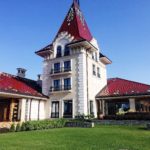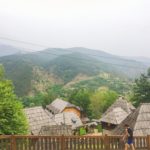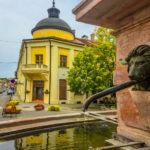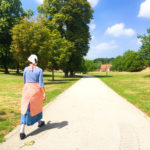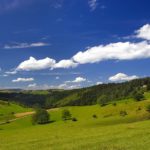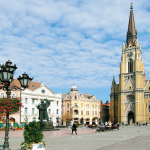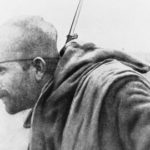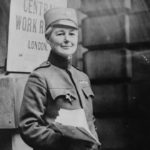An eight-day stay in Serbia is not enough to see all the beauties of this incredible country. However, it’s exactly the right amount of time to get acquainted with its geographical, religious and cultural diversity. On this tour we had a glance of Belgrade then turned to the lush mountains of west Serbia and concluded with a day in the north of the country where central European influences prevail.
There are two things about this tour you need to know when reading this. Firstly, the group came from Cairo; they were all Coptic Christians, all from the same parish and led by their priest. Needless to say, they were very religious so the Magellan team tailored the trip to their needs; we lingered a bit more than usual in churches and monasteries but I was very happy that they showed interest in our religious art and practices. Their second wish was to see as many natural beauties as possible; thus we headed for the mountains that stay fresh and green even in the middle of summer. Thirdly, except for a few grownups with their kids, everyone else was in their late teens, which meant that there was lots of energy, be it for walking, playing or singing. A truly unique and remarkable group!
Day 1: Belgrade
I met the group very early in the morning as they arrived at their hostel. They were quite tired so that we took our time enjoying coffee and juices. After breakfast, we headed first to see the Church of St Sava, the largest church in Belgrade and indeed one of the three largest churches in the whole of Orthodox Christianity. After that it was time for a visit to the House of Flowers; this is a popular name for the final resting place of socialist Yugoslavia’s lifelong president, Tito. In fine weather, we enjoyed the surrounding park as well as the museum that stands next to Tito’s grave.
After a much-needed siesta, the afternoon was reserved for a walking tour through the city center starting with Terazije and the stately Hotel Moskva, via the pedestrian Trg Republike Square and Kneza Mihaila Street to the Kalemegdan Park surrounding the massive walls of the Citadel. Here we spent more time marveling at Belgrade’s two large rivers, inspecting the monuments from the past, especially the Ružica Church, once the church of the local garrison and thus embellished with curious details from WWI.
Day 2: Belgrade – Topola – Žiča – Studenica
Today we headed south. Leaving the highway, we ventured into the scenery of rolling hills to reach the town of Topola, a small place but one of enormous significance for Serbian history. Crowning the hill above the town stands the mausoleum church of the Serbian royal dynasty, the Karadjordjevićs. Outside its all shiny marble, inside – glittering mosaics made out of 30 million pieces of stones in hundreds of colors that never fail to impress. Underneath the church lies a dimly lit but equally beautiful crypt where all the members of the royal house lay buried. After that, it was time for a visit to the local museum explaining the rise of dynasty’s founder Karadjordje and to a modest church which he built two centuries ago.
An hour and a half drive away stood our next goal – the monastery of Žiča. Famous as the place where Serbian rulers came to be crowned, Žiča is nowadays a thriving complex of sanctuaries and dwellings for nuns who keep it in perfect order. As our guest has noted, it is also quite commercial with unusually well-supplied monastery shops.
From Žiča the road enters the mostly barren and very narrow valley of the River Ibar. At its beginning, we made a lunch stop at a cozy century and a half old inn for some very tasty Serbian specialties served by friendly owners. Filling our stomachs to the top was not unintentional here since I warned the group that cuisine at the monastic hostelry for that evening would be very monastic.
After a very short break underneath Maglič Castle, we continued. Soon, the brown and yellow scenery of Ibar valley gave way to the green around the river Studenica that led us deeper into mountains. It was late in the afternoon when we checked in at the quiet hostelry just outside the walls of Studenica Monastery. Run by the monks and their novices this is the quite basic but pleasant establishment. Since the monastery gates close as early as 7.pm we only had time to glance at the exterior of monastery’s three churches, above all at the Mother of God church, whose Romanesque exterior is adapted to the Byzantine plan of the church, a unique feature of Serbian medieval art that can not be observed anywhere else. The rest of the sightseeing had to be left for tomorrow morning. The dinner, consisting of fish and potatoes was surprisingly abundant but, as always, cooked in a very dull way. That’s the way the like it here.
Day 3: Studenica – Gradac – Novi Pazar – Sopocani – Mileseva
Meeting the group at 7.30 AM I was the last and the only one who missed the matins. Still, I was right on time for the inspection of the frescoes in two of Studenica’s churches. As we ended our small tour we were met by the abbot who invited this group from afar to join him for a coffee, juice and šljivovica, Serbian plum brandy. We felt much honored and enjoyed the chat with the learned man.
After the most basic of breakfasts, we pushed on southwards to one more monastery – Gradac. Another architectural gem, a combination of Gothic and Byzantine styles, Gradac is smaller and quieter, a place where you can enjoy the buzzing of the bees and bird songs.
Our next stop was the town of Novi Pazar, oriental in looks and feel, the seat of Serbian speaking Muslim community of Serbia. Here we had a small walk but the group was unimpressed since they concluded that it’s pretty similar to what they have back home in Cairo! Hence we continued to the nearby Sopoćani Monastery. Only ten minutes drive from Novi Pazar, the monastery seems to be in another world. Its sober exterior hides some of the best frescoes of the entire 13th century, the prime reason that secured its place on the UNESCO World Heritage list.
We were now in for a lengthier drive, but a very interesting one. Though the group was chatting and singing (!) this gave way to taking photos and sighs of admiration as we drove across the Sjenica highland, an out of this world scenery of vast yellow and green pastures.
Mileševa Monastery lies 10km away from the town of Prijepolje but offers the best accommodation for groups at its dwellings. Since we arrived late we left the sightseeing for the morning and went for our dinner to Prijepolje and then back to the monastery for a night of good night sleep.
Day 4: Mileseva – Sopotnica – Sirogojno – Stopica Cave – Zlatibor
We started the day with sightseeing of the church, its famed frescoes as well as the rich treasury. The evening before we decided to change the plan a bit: instead of going to the Uvac River which is slightly further away, the group decided to listen to my advice and visit the nearby village of Sopotnica. Though not far from Prijepolje, Sopotnica is high up in the mountains and the road leading to it is not good. We were lucky that our mini-bus was of exact size so that we could pass by the logging trucks, but this would be impossible without our driver’s prowess. For a group from Cairo Sopotnica was one of the highlights of the journey: green, with views far and wide and – most importantly – with water splashing in vast quantities down the cascades of its waterfalls. After a lengthy stay and a lot of photos, we slowly negotiated our way back on the main road.
The day continued with a visit to Sirogojno village and its open-air museum presenting the architecture and daily life of farmers in this part of Serbia until a hundred years ago. This is also where we had our lunch in the museum’s restaurant which prepares delicious olden days dishes.
Since we still had some time on our hands we decided to visit the neighboring Stopića Pećina Cave. We parked a bit further away and had a nice walk through the woods to the cave’s impressive opening. With a stream, a waterfall and a few more curious sights, this presented a perfect end to our day.
Still, we had about half an hour more driving to the hotel and a good deal of it was extremely scenic, perhaps even more than the scenery from yesterday. No wonder that this highland is called Zlatibor, “Golden Pine”.
After the check in to our hotel, we used the pleasantly fresh evening to stroll a bit through the resort of Zlatibor.
Day 5: Zlatibor
The idea was that after four days of rather tightly packed schedule we would take a day’s break at this beautiful spot. After a late start, the guests split: some went biking (this is a very good area for that since it’s mostly flat), some went to Tornik, the highest peak in the vicinity (1,496m) and some, including me, just went for a leisurely walk around the place. In the evening we all got together and I decided to learn them a bit about the Serbian language and alphabet. Of course, this inevitably led to me learning a bit of Coptic, which produced a lot of good laughs.
Day 6: Zlatibor – Mokra Gora – Mećavnik – Kremna – Mt Tara
This morning we had a leisurely start: we had plenty of time to reach the beautiful village of Mokra Gora and the starting point of the narrow gauge railway. From the valley, the old train rose the hill on a dazzling route creating opportunities for great vistas and photos. After the ride, we dropped by Mećavnik Hill where the celebrated film director Emir Kusturica has built his “Wooden Town” that includes a cinema hall, kindergarten, church and – inevitably – a restaurant.
After a plentiful lunch, we headed back across the golden expanses of Zlatibor and than turned northwards. A shortstop in the village of Kremna was used for photos of old houses, cows, and sheep but also for a glance at the home of local celebrities, the Tarabićs, who made this village famous with their curious prophecies back in the 19th century.
Pushing through Mount Tara’s woods we made it to our home for the night, a clearing with a hotel for school kids and a few dozen holiday homes. For that small rest of the afternoon, we were off for a walk culminating at the Banjske Stijene Rocks rising hundreds of meters above River Drina. Dusk arrived at this truly awesome place together with hymn singing from old Egypt and I must admit the atmosphere was intensely spiritual even for an outsider like me.
To make it back before dark we called the driver who picked us up, driving directly to dinner in a small restaurant that opened that evening just for us.
Day 7: Tara – Drina – Kadinjača – Blagoveštenje Monastery – Belgrade
We left our pension while Tara’s forests were still covered in mist. Unfortunately, this was the cloudiest and coldest morning since we started from Belgrade and on this very day, the group was scheduled for a bit of rafting down River Drina. They still decided to do it and managed to make about 2/3 of it when it started raining. Driver and I “saved” them in the first place where the rubber boats could moor. We continued as the sun slowly appeared again in the sky…
Driving eastwards for the first time in days we reached Kadinjača, a pass above the city of Užice where an impressive memorial commemorates a heroic stand by communist partisans unit against advancing Nazis in 1941. The group found the huge white boulders arranged in geometric shapes perfect for photos. Returning to our bus, we found ourselves in the middle of a wedding: several cars with guests have stopped by to regroup, play loud music, sing, dance kolo and, of course, drink. This meant that I had to frantically translate for the next 20 minutes, explaining to both confused parties what was going on!
Passing Užice we reached the forbidding Ovčar-Kablar Gorge where about a dozen small Orthodox Monasteries are nested. We visited one of the oldest and prettiest – Blagoveštenje with its dark-colored frescoes and a contrasting gilded iconostasis.
After a long ride, we were back where we started six days ago, in our Belgrade hotel.
Day 8: Krušedol – Sremski Karlovci – Petrovaradin – Novi Sad
On our last day, we headed northwards to different scenery – vast fields covered in wheat, corn, and sunflowers. After an hour’s drive ending with a bit of hill, we reached the much revered Krušedol Monastery, as historic as it is pretty. This meeting of baroque and Orthodox Christianity resulted in a memorable mix that left our group enchanted.
Just a few minutes away we stopped for a visit to Sremski Karlovci, a small town of great beauty. We walked across its main square, ventured into the grand Orthodox Cathedral, passed the old high school and town hall to reach the Lower Church and a huge plane tree in front of it.
Conveniently close to Sremski Karlovci lies the Petrovaradin Fortress, hovering above the Danube and the city of Novi Sad on the opposing riverbank. The guests were impressed foremost by the panorama but also by the stout walls and historic barracks of the fortress. We made around and then headed across the river to dive into the center of Novi Sad. I based my tour there on its beautiful streets and buildings as well as the cultural diversity of this vibrant town, but colorful cafés and plenty of opportunities for shopping were also noted by the group (and then used in their free time!).
In the late afternoon, we turned back towards Belgrade, reaching it after an hour on the highway. Thus concluded our eight-day tour of Serbia. The group was very satisfied, delighted by nature, different both from that of Egypt as well as from that of western Europe where they went before. We said goodbye as they promised to visit again and I promised to give them a call when visiting Egypt.


